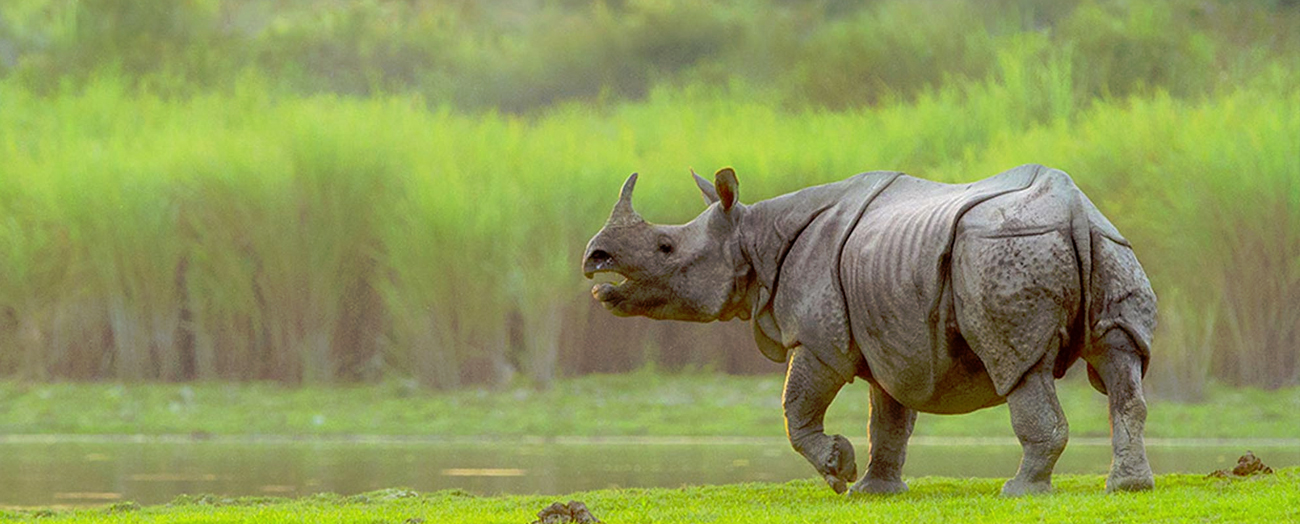
Kaziranga
Kaziranga is a National Park in the state of Assam, in India. It was a “Game Sanctuary” and a “Proposed Reserve Forest” during the colonial era of pre-independence India. It was declared a National Park in 1968 by the Assam state government through the Assam National Park Act and was recognised by the Central Government as a National Park later in 1974. By then it had expanded, preserved and demarcated within an area of around 430 sq. km and this area of immense bio-diversity was declared as “World Heritage Site” by UNESCO in 1985.
Kaziranga is a National Park in the state of Assam, in India. It was a “Game Sanctuary” and a “Proposed Reserve Forest” during the colonial era of pre-independence India. It was declared a National Park in 1968 by the Assam state government through the Assam National Park Act and was recognised by the Central Government as a National Park later in 1974. By then it had expanded, preserved and demarcated within an area of around 430 sq. km and this area of immense bio-diversity was declared as “World Heritage Site” by UNESCO in 1985.Kaziranga has since then became a major tourist attraction on a global scale and naturally so as it is the “home” of around two-thirds of world one-horned rhinoceros in the protected areas of the world. Rhinos are in fact the state animal and symbol of Assam. Conservation of Rhino is such a sensitive matter for the people of the region that it has become a political issue in state elections. Poaching is frowned upon unanimously and failure to stop poaching is seen as failure of state machinery. Assam state administration under due public pressure had dealt with the situation that special force group trained with automatic weapons are being organized for the protection of rhinos and also tigers in the Kaziranga National Park. The check on poaching is so strong in fact it drew flak from British Broadcasting Corporation (BBC), which in a documentary called the anti-poaching methods a “dark secret” of the administration since the thumb rule for the guards are to “shoot at sight” any poachers are found illegally entering the National Park. However, so much support was given by the public to the government on the ruthless but effective way that, Government of India incidentally banned BBC for the next five years starting from April 10th, 2017 from filming in any of the country’s National Park.
Kaziranga National Park is centrally located in Assam, whether travellers approach it from Guwahati airport or Jorhat/Dibrugarh airport. Different categories of hotels/resorts/eco camps are available at the park’s vicinity. Travellers can enjoy the fresh lease of air in the morning or sleeping in the night with the sound of the jungle singing a lullaby. Jeep Safaris and elephant rides are arranged accordingly and travellers can take time visiting the different ranges of the park. Recent noted visitors were the British Royal couple Prince William and Princess Kate Middleton who were enthralled by the jeep safari they participated in. The park has been a major tourist destination on a national and global scale; missing in on visiting it is depriving oneself of a great leisure adventure trip.
Travellers visiting the park while during their elephant/jeep safari can come across animals like: 1) Greater one horned rhinoceros, 2) Asiatic wild buffaloes, 3) Eastern swamp deer, 4) Elephants, 5) Sambar, 6) Hog deer, 7) Indian muntjac, 8) Bengal Tiger, 9) Leopard cat, 10) Fishing cat, 11) Golden Jackal, 12) Golden Fox, 13) Sloth bear, 14) Large Indian Civet, 15) Assamese Macaque, 16) Capped langur, 17) Golden langur, 18) Hollock gibbon, 19) Barking deer and the unique river water dolphin Ganges Dolphin etc.Birds of Kaziranga are: Birdlife International (formerly International Council for Bird Preservation) has declared Kaziranga as Important Bird Area (IBA), which means that “is an area identified using an internationally agreed set of criteria as being globally important for the conservation of bird populations.” Birds found in Kaziranga are:1) Lesser white fronted goose, 2) Ferugginous duck, 3) Baer’s Poached duck, 4) Lesser/Greater/Black necked adjutant stork, 5) Asian open billed stork, 6) White bellied Heron, 7) Dalmatian Pelican, 8) Nordmann’s greenshack, 9) Blac-bellied Tern, 10) Eastern Imperial eagle, 11) Great spotted eagle, 12) White tailed eagle, 13) Grey headed fish eagle, 14) Lesser Kestel, 15) Slender billed vulture, 16) Indian white-rumped vulture, 17) Swamp francolin, 18) Bengal Florican, 19) Great Indian hornbill etc.
